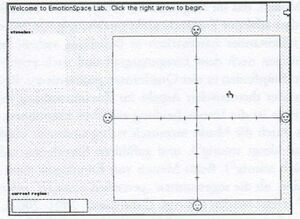Translations:Bisherige "continuous response" - Systeme/3/en
EmotionSpace Lab
EmotionSpace Lab (ESL) was developed in 1996 by Australian music psychologist Emery Schubert and is the first program to use 2DES. The control works with the mouse. Smileys for clarification are provided at each end of the axes, and visual stimuli can be shown next to the emotion space. In addition to the cursor, the horizontal position is visualized at the bottom left, as shown in Figure 3.1. The axes are scaled equally, valence is indicated horizontally, and activity is indicated vertically. Possible stimuli are words and pictures in addition to audio files, which are displayed next to the 2DES (Kopiez et al. 2011, p. 132f.). The ESL uses a sample rate of 2 Hz, or two samples per second. This was justified by the fact that changes in activity estimation in response to volume changes occurred only 1-3 seconds after the acoustic event. According to the Nyquist-Shannon sampling theorem (Benson 2007, p. 254f.), the sample rate must be at least twice as high as the expected frequency of the signal, i.e. two samples per second, in order to be able to evaluate with second precision (Schubert 2010, p. 225).
